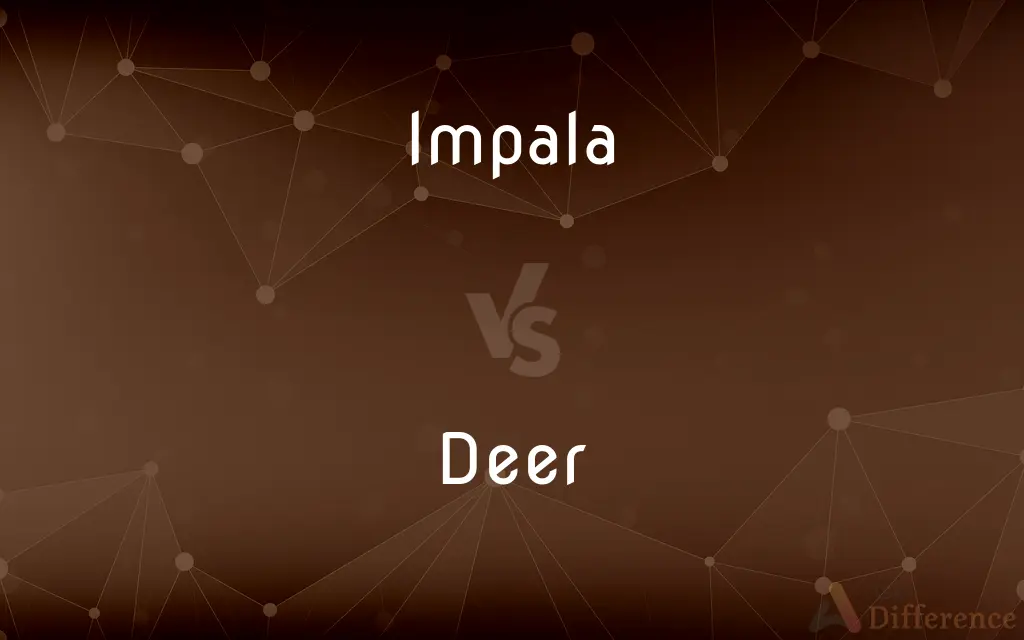Impala vs. Deer — What's the Difference?
By Maham Liaqat & Fiza Rafique — Updated on April 23, 2024
Impalas are medium-sized antelopes native to Africa, known for their long, spiral horns and ability to leap, while deer are a more diverse group found worldwide, varying greatly in size and lacking the distinctive horns of impalas.

Difference Between Impala and Deer
Table of Contents
ADVERTISEMENT
Key Differences
mpalas are specifically adapted for life in the African savannahs, possessing powerful hind legs that allow them to jump distances of up to 10 meters and heights of about 3 meters. In contrast, deer species are adapted to a variety of global environments from Arctic tundras to tropical rainforests, and their jumping abilities are generally less pronounced than those of impalas.
While impalas are known for their reddish-brown coats and distinctive black markings, deer vary widely in coloration, from the deep browns of the mule deer to the spotted fawns of many species. This variety in deer is a result of their adaptation to diverse environments and climates.
The social structure of impalas involves herds that can include dozens of individuals, usually segregated by except during mating seasons. On the other hand, deer social structures vary widely; some species are solitary except during mating seasons, while others, like the European red deer, form large herds.
Regarding diet, impalas are mixed feeders, grazing on grasses and browsing on shrubs, depending on the season. Deer, however, have more varied diets that can range from strictly grazing in the case of some species to mixed feeding strategies similar to those of impalas.
One of the most striking differences is in the horns. Male impalas have long, lyre-shaped horns, which they use in territorial fights. Conversely, most deer species have antlers, which are shed and regrown annually, and can be used for similar purposes in different species.
ADVERTISEMENT
Comparison Chart
Habitat
African savannahs
Diverse: forests, tundras, grasslands
Horns/Antlers
Spiral horns, only in males
Antlers, mostly males, shed annually
Diet
Mixed feeder (grasses and shrubs)
Varies widely, from grazers to browsers
Jumping Ability
Can leap 10m across, 3m high
Less pronounced, varies by species
Compare with Definitions
Impala
Usually lives in large herds during non-breeding seasons.
A herd of impala grazed quietly under the acacia trees.
Deer
A widely distributed family of hoofed animals with species adapted to various environments.
The deer cautiously stepped out of the forest into the meadow.
Impala
Capable of jumping remarkable distances both vertically and horizontally.
The impala escaped the predator by making a series of spectacular jumps.
Deer
Diet varies significantly among species, from grasses to mixed vegetation.
The deer foraged for berries and twigs as winter approached.
Impala
Primarily a grazer, but shifts to browsing depending on the season.
During the dry season, the impala browsed on leaves more than grass.
Deer
Coloration and size vary greatly depending on the species and environment.
The fawns' spotted coats helped them blend into the forest floor.
Impala
A medium-sized antelope found in eastern and southern Africa.
The impala leapt gracefully over the brush.
Deer
Social behavior ranges from solitary to forming large herds.
During mating season, the deer gathered in a large herd in the valley.
Impala
Known for its reddish coat and long, spiral horns.
Each male impala's horns were nearly 90 centimeters long.
Deer
Most species grow antlers that are shed and regrown each year.
The old deer's antlers were the largest in the herd.
Impala
The impala (, Aepyceros melampus) is a medium-sized antelope found in eastern and southern Africa. The sole member of the genus Aepyceros, it was first described to European audiences by German zoologist Hinrich Lichtenstein in 1812.
Deer
Deer or true deer are hoofed ruminant mammals forming the family Cervidae. The two main groups of deer are the Cervinae, including the muntjac, the elk (wapiti), the red deer, the fallow deer, and the chital; and the Capreolinae, including the reindeer (caribou), the roe deer, the mule deer, and the moose.
Impala
A graceful antelope often seen in large herds in open woodland in southern and East Africa.
Deer
Any of various hoofed ruminant mammals of the family Cervidae, characteristically having deciduous antlers borne chiefly by the males. The deer family includes the white-tailed deer, elk, moose, and caribou.
Impala
A reddish-brown African antelope (Aepyceros melampus) that has long, curved horns in the male and is noted for its ability to leap.
Deer
A ruminant mammal with antlers and hooves of the family Cervidae, or one of several similar animals from related families of the order Artiodactyla.
Impala
An African antelope, Aepyceros melampus, noted for its leaping ability; the male has ridged, curved horns.
Deer
(in particular) One of the smaller animals of this family, distinguished from a moose or elk
I wrecked my car after a deer ran across the road.
Impala
An antelope (Aepyceros melampus) of Southeastern Africa, the male of which has ringed lyre-shaped horns, which curve first backward, then sideways, then upwards. ALso called impalla and pallah.
Deer
The meat of such an animal; venison.
Oh, I've never had deer before.
Impala
African antelope with ridged curved horns; moves with enormous leaps
Deer
Any animal, especially a quadrupedal mammal as opposed to a bird, fish, etc.
Deer
Any animal; especially, a wild animal.
Mice and rats, and such small deer.
The camel, that great deer.
Deer
A ruminant of the genus Cervus, of many species, and of related genera of the family Cervidæ. The males, and in some species the females, have solid antlers, often much branched, which are shed annually. Their flesh, for which they are hunted, is called venison.
Deer
Distinguished from Bovidae by the male's having solid deciduous antlers
Common Curiosities
Do impalas and deer have similar breeding behaviors?
Both impalas and deer engage in mating behaviors that can involve males displaying their physical prowess, but specific rituals and structures like lekking in impalas are not commonly observed in deer.
Are impalas found outside of Africa?
Impalas are native to Africa and are not naturally found in the wild outside this continent, unlike deer, which are distributed across various continents.
What are the primary dietary habits of impalas and deer?
Impalas are mixed feeders, alternating between grazing and browsing, whereas deer's diets can range from strictly grazing to mixed, depending on the species.
How do impalas defend themselves from predators compared to deer?
Impalas use their speed and incredible jumping ability to evade predators, while deer might use speed, camouflage, or staying motionless to avoid detection.
How does the coloration of impalas and deer differ?
Impalas typically have a consistent reddish-brown coat with distinctive black markings, whereas deer can vary significantly in color based on species, age, and season.
What are some unique behaviors seen in impalas that are not observed in deer?
Impalas engage in a behavior known as stotting or pronking, which is a high, stiff-legged leap, as a possible anti-predator strategy, which is not typically seen in deer.
How do impalas and deer respond to environmental changes?
Both impalas and deer are adaptable to changes in their habitats, though their specific responses can vary greatly depending on their respective environments.
What are the lifespan differences between impalas and deer?
Impalas typically live about 12 to 15 years in the wild, similar to many deer species, although this can vary widely among different deer species.
What is the impact of human activities on impalas and deer?
Both impalas and deer are affected by habitat loss and hunting; however, their responses and adaptations to human encroachment can differ, impacting their survival and distribution.
What are the size comparisons between impalas and deer?
Impalas are generally medium-sized with a height around 75 to 95 cm at the shoulder, which is smaller than many deer species like the red deer but similar to smaller deer like the roe deer.
How do impalas interact with their environment compared to deer?
Impalas often affect the savannah ecosystems by grazing and browsing, similar to how deer impact their varied environments through their feeding habits and movement patterns.
Can impalas and deer coexist in the same habitat?
Impalas and deer do not naturally coexist as they are native to different continents and ecosystems.
What are the conservation statuses of impalas and deer?
Most impala populations are considered stable, but some deer species, like the Key deer, are endangered, highlighting the varying conservation needs.
How do the reproductive strategies of impalas differ from those of deer?
Impalas have a distinct breeding season with synchronized births, whereas deer may have a more prolonged breeding season with less synchronization.
Share Your Discovery

Previous Comparison
Diaphysis vs. Epiphysis
Next Comparison
Dozen vs. KilogramAuthor Spotlight
Written by
Maham LiaqatCo-written by
Fiza RafiqueFiza Rafique is a skilled content writer at AskDifference.com, where she meticulously refines and enhances written pieces. Drawing from her vast editorial expertise, Fiza ensures clarity, accuracy, and precision in every article. Passionate about language, she continually seeks to elevate the quality of content for readers worldwide.
















































